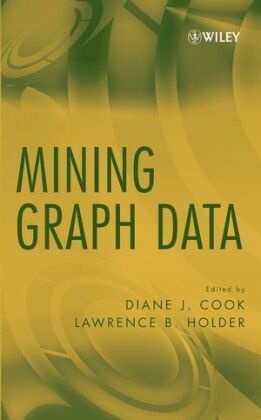Read more
Informationen zum Autor DIANE J. COOK , PhD, is the Huie-Rogers Chair Professor in the School of Electrical Engineering and Computer Science at Washington State University. Her extensive research in artificial intelligence and data mining has been supported by grants from the National Science Foundation, NASA, DARPA, and Texas Instruments. Dr. Cook is the coauthor of Smart Environments: Technology, Protocols, and Applications (Wiley). LAWRENCE B. HOLDER , PhD, is Professor in the School of Electrical Engineering and Computer Science at Washington State University, where he teaches and conducts research in artificial intelligence, machine learning, data mining, graph theory, parallel and distributed processing, and cognitive architectures. Klappentext Discover the latest data mining techniques for analyzing graph dataThis text takes a focused and comprehensive look at an area of data mining that is quickly rising to the forefront of the field: mining data that is represented as a graph. Each chapter is written by a leading researcher in the field; collectively, the chapters represent the latest findings and applications in both theory and practice, including solutions to many of the algorithmic challenges that arise in mining graph data. Following the authors' step-by-step guidance, even readers with minimal background in analyzing graph data will be able to represent data as graphs, extract patterns and concepts from the data, and apply the methodologies presented in the text to real datasets.Mining Graph Data is divided into three parts:* Part I, Graphs, offers an introduction to basic graph terminology and techniques.* Part II, Mining Techniques, features a detailed examination of computational techniques for extracting patterns from graph data. These techniques are the state of the art in frequent substructure mining, link analysis, graph kernels, and graph grammars.* Part III, Applications, describes the application of data mining techniques to four graph-based application domains: chemical graphs, bioinformatics data, Web graphs, and social networks.Practical case studies are included in many of the chapters. An accompanying Web site features source code and datasets, offering readers the opportunity to experiment with the techniques presented in the book as well as test their own ideas on graph data. The Web site also includes the results of many of the techniques presented in the text.This landmark work is intended for students and researchers in computer science, information systems, and data mining who want to learn how to analyze and extract useful patterns and concepts from graph data. Zusammenfassung This books illustrates how data mining techniques, through the application of algorithms and graphs, have been responding to the need for the collection and storage of larger and more complex volumes of data. Inhaltsverzeichnis Preface. Acknowledgments. Contributors. 1 INTRODUCTION ( Lawrence B. Holder and Diane J. Cook ). 1.1 Terminology. 1.2 Graph Databases. 1.3 Book Overview. References. Part I GRAPHS. 2 GRAPH MATCHING-EXACT AND ERROR-TOLERANT METHODS AND THE AUTOMATIC LEARNING OF EDIT COSTS ( Horst Bunke and Michel Neuhaus ). 2.1 Introduction. 2.2 Definitions and Graph Matching Methods. 2.3 Learning Edit Costs. 2.4 Experimental Evaluation. 2.5 Discussion and Conclusions. References. 3 GRAPH VISUALIZATION AND DATA MINING ( Walter Didimo and Giuseppe Liotta ). 3.1 Introduction. 3.2 Graph Drawing Techniques. 3.3 Examples of Visualization Systems. 3.4 Conclusions. References. 4 GRAPH PATTERNS AND THE R-MAT GENERATOR ( Deepayan Chakrabarti and Christos Faloutsos ). 4.1 Introductio...
List of contents
Preface.
Acknowledgments.
Contributors.
1 INTRODUCTION (Lawrence B. Holder and Diane J. Cook).
Part I GRAPHS.
2 GRAPH MATCHING--EXACT AND ERROR-TOLERANT METHODS AND THE AUTOMATIC LEARNING OF EDIT COSTS (Horst Bunke and Michel Neuhaus).
3 GRAPH VISUALIZATION AND DATA MINING (Walter Didimo and Giuseppe Liotta).
4 GRAPH PATTERNS AND THE R-MAT GENERATOR (Deepayan Chakrabarti and Christos Faloutsos).
Part II MINING TECHNIQUES.
5 DISCOVERY OF FREQUENT SUBSTRUCTURES (Xifeng Yan and Jiawei Han).
6 FINDING TOPOLOGICAL FREQUENT PATTERNS FROM GRAPH DATASETS (Michihiro Kuramochi and George Karypis).
7 UNSUPERVISED AND SUPERVISED PATTERN LEARNING IN GRAPH DATA (Diane J. Cook, Lawrence B. Holder, and Nikhil Ketkar).
8 GRAPH GRAMMAR LEARNING (Istvan Jonyer).
9 CONSTRUCTING DECISION TREE BASED ON CHUNKINGLESS GRAPH-BASED INDUCTION (Kouzou Ohara, Phu Chien Nguyen, Akira Mogi, Hiroshi Motoda, and Takashi Washio).
10 SOME LINKS BETWEEN FORMAL CONCEPT ANALYSIS AND GRAPH MINING (Michel Liquière).
11 KERNEL METHODS FOR GRAPHS (Thomas Gärtner, Tamás Horváth, Quoc V. Le, Alex J. Smola, and Stefan Wrobel).
12 KERNELS AS LINK ANALYSIS MEASURES (Masashi Shimbo and Takahiko Ito).
13 ENTITY RESOLUTION IN GRAPHS (Indrajit Bhattacharya and Lise Getoor).
Part III APPLICATIONS.
14 MINING FROM CHEMICAL GRAPHS (Takashi Okada).
15 UNIFIED APPROACH TO ROOTED TREE MINING: ALGORITHMS AND APPLICATIONS (Mohammed Zaki).
16 DENSE SUBGRAPH EXTRACTION (Andrew Tomkins and Ravi Kumar).
17 SOCIAL NETWORK ANALYSIS (Sherry E. Marcus, Melanie Moy, and Thayne Coffman).
Index.
Report
"...individuals with no background analyzing graph data can learn how to represent the data as graphs, extract patterns or concepts from the data, and see how researchers apply the methodologies to real datasets." ( Computing Reviews.com , March 23, 2007)

